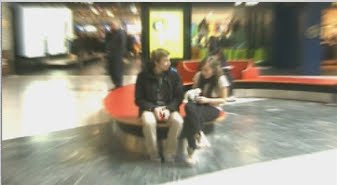We agreed as a group, that in order to achieve a good grade, we needed outstanding Mise en scene, great cinematography and an inspiring performance. We made sure we had a solid shot list to use on the video and used real media products such as final cut pro for our editing. We were prepared like any other media product

By Michael and Bethan
Like the majority of music videos, we have included close up shots of the performer's face and mouth to capture the lip syncing effectively. Lip syncing is often part of the post-production phase; real music videos include lip syncing to give the initial impression that the performer is singing live with their natural vocal ability. This is done to hide the fact that it is pre-recorded and edited to improve the sound quality. For our music video, we included lip syncing initially to make our performer look like he was the actual singer of the song, Ryan Star. We included lip syncing throughout the whole of the song so that we would have a substantial amount of shots that we could choose from, in case some areas weren't of a high enough performance standard. It made sense to choose sections from one whole length of lip syncing, as appose to having inadequate amounts of little short ones, with the chance of having to film again if we didn't like the shot. Also, this popular technique was included as it is a popular element used in all music videos. By including the celebrity performer it primarily promotes the artist and the song itself.
Particularly for lip syncing purposes, we decided further that we wanted to create a master performance of the lead singer in the video, like many other real media products have done, one of the most popular examples are, Sinead O'Connor - Nothing Compares to You, and the dance sequence from Beyonce - Single Ladies.
To achieve the best quality like other media products, we used the college’s studio so that we could capture the best definition of shots with the high tech cameras. Due to the song being a powerful soul rock ballad, we dimmed the lighting whilst creating some spot light effects. Handheld cameras were also included to capture the singer (me) lip syncing for the whole song, even in the areas we defiantly didn’t need.
Our media product can be linked to real media products because we also included narrative and performance within our finished product.
Below Insert: Halle Square inside Manchester Arndale was one of a number of areas where we were asked to stop filming due to no permission.

When producing our music video we faced many problems, mianly not allowed permission to fulm in private areas around Manchester.
We did not gain any planning permission as we only had a few weeks to film and it was not considered enough time to gain access to do what we ideally wanted to film. To overcome the problem, we still filmed in the locations we wanted, quickly and quietly, in some cases a one shot take had to be done as we were being moved on during the actual filming process. If we would have been a popular, professional media company we would not have faced these problems, as they are be able to pay to hire areas and have permission to film in places where we are most definitely not.
We challenged conventions of real media products through a variety of tripods shots. We were going to use a lot of hand held clips, to give a sense of a P.O.V shot of the audiences perception of the performer in the video, to make them feel more involved and included, instead of just a viewer.
Another way that we challenged media products was perhaps through the costume worn. Whereas most celebrities wear extravagant, expensive branded clothing, we decided to wear casual clothes. This was because our target audience was primarily students, because of ourselves being students, there would be an immediate connection. It is showed the performer to come across as a regular person, so that there would be a better link. The dress code can also be linked with other media products, as we are also stereotyping students by portraying them as dressing casually whilst still staying with the late fashion trend, but still looking slightly untidy.
To conclude, I feel that we managed to follow popular media guidelines to create a highly quality piece of work, worth a deserving good grade. I also feel that we added our own adopted techniques to the video to make it a totally unique one, whilst still adapting other successful elements, to make our media product look equally as professional.
By Michael and Bethan
No comments:
Post a Comment